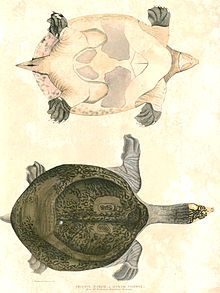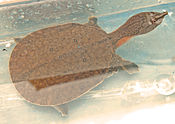Indian peacock softshell turtle
Appearance
(Redirected from Gymnopus ocellatus)
| Indian peacock softshell turtle | |
|---|---|

| |
| Scientific classification | |
| Domain: | Eukaryota |
| Kingdom: | Animalia |
| Phylum: | Chordata |
| Class: | Reptilia |
| Order: | Testudines |
| Suborder: | Cryptodira |
| Family: | Trionychidae |
| Genus: | Nilssonia |
| Species: | N. hurum
|
| Binomial name | |
| Nilssonia hurum (Gray, 1831)[1]
| |
| Synonyms[3] | |
| |
Indian peacock softshell turtle (Nilssonia hurum) is a species of turtle found in South Asia and is listed on the IUCN Red List as a vulnerable species.

Geographical range
[edit]The Indian peacock soft-shell turtle is found in Bangladesh, India (the states of Mizoram, Assam, Bihar, Madhya Pradesh, Odisha, Rajasthan, Uttar Pradesh, West Bengal), Nepal and Pakistan.[1]
Type locality in India: Fatehgarh, Ganges, to Barrackpore (about 23 kilometers north of Calcutta), West Bengal, India".[4]
References
[edit]- ^ a b c Das, I.; Choudhury, B.C.; Ahmed, M.F.; Praschag, P.; Singh, S. (2021). "Nilssonia hurum". IUCN Red List of Threatened Species. 2021: e.T39619A2931203. doi:10.2305/IUCN.UK.2021-1.RLTS.T39619A2931203.en. Retrieved 19 November 2021.
- ^ "Appendices | CITES". cites.org. Retrieved 2022-01-14.
- ^ Fritz 2007, p. 000.310
- ^ Webb, R.G. 1980 Gray, Hardwicke, Buchanan-Hamilton, and drawings of Indian soft-shell turtles (Family Trionychidae). Amphibia-Reptilia 1: 61-74. Webb (1980: 71)
- Bibliography
- Fritz, Uwe; Havaš, Peter (2007). "Checklist of Chelonians of the World" (PDF). Vertebrate Zoology. 57 (2). Archived from the original (PDF) on 2011-05-01.
Further reading
[edit]- Safi, A., Khan, M. Z.,2014. Distribution and current population of freshwater turtles of District Charsadda of Khyber Pakhtunkhwa, Pakistan. The Journal of Zoology studies. 1(4): 31–38. http://www.journalofzoology.com
- Anderson, J. 1872 Note on Trionyx gangeticus, and Trionyx hurum, B. Hamilton. Ann. Mag. Nat. Hist. (4) 9: 382-383
- Anderson, J. 1872 On Trionyx gangeticus, Cuvier, Trionyx hurum, B.H. and Dr. Gray. Ann. Mag. Nat. Hist. (4) 10: 219-222
- Gray, J. E. 1831 A synopsis of the species of Class Reptilia. In: Griffith, E & E. Pidgeon: The animal kingdom arranged in conformity with its organisation by the Baron Cuvier with additional descriptions of all the species hither named, and of many before noticed [Vol. 9]. Whittaker, Treacher and Co., London: 481 + 110 pp.
- Gray, J.E. 1872 On Indian Mud-Tortoises (Trionyx). Ann. Mag. Nat. Hist. (4) 9: 473-475
- Meylan, P.A. 1987 The phylogenetic relationships of soft-shelled turtles (Family Trionychidae). Bulletin of the American Museum of Natural History 186 (1):1-101.


